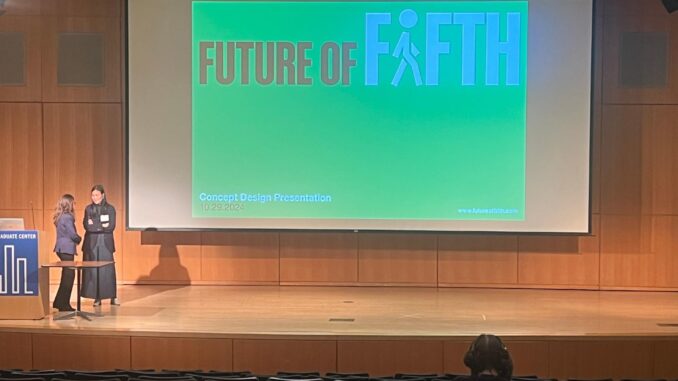
BY ANGELINA BANEK
On Tuesday, Oct. 29th, Future of Fifth invited the public to an open house at the CUNY Graduate Center on proposed changes to Fifth Avenue between Bryant Park and Central Park. Future of Fifth is a partnership between New York City Chief Public Realm Officer Ya-Ting Liu and multiple city agencies to transform and improve the space for visitors.
“Fifth Avenue is one of the most famous streets in the world, and yet there has not been a public investment in over 120 years,” said Madelyn Wils, Interim President of the Fifth Avenue Association and co-chair of a future Fifth Avenue steering committee.
“It [Fifth Avenue] also generates over 3.9 billion dollars in taxes and what that means is that 4.5% of those taxes actually go back to the city to fund our city improvements,” said Isabel Castilla, an Associate Partner for Field Operations. “So it is really important that we continue supporting Fifth Avenue as an economic engine, which eventually does impact the entire city at large.”
Home to iconic attractions, including Bryant Park, St. Patrick’s Cathedral, and Rockefeller Center, Fifth Avenue is used by approximately 5,477 pedestrians every day. But, recent survey data presented during the open house shows they typically spend less than two hours on the street, and 75% of people use negative words to describe their experiences. The $350 Million facelift aims to change this by creating more greenspace, wider sidewalks, and design elements that highlight key attractions.
“Pedestrians are the number one transportation mode on Fifth Avenue and it’s important to keep people wanting to come to Fifth for a variety of reasons,” said Wils.
The plan aims to make Fifth Avenue more pedestrian-centered, but there will still be car and bus lanes on the boulevard. The proposal illustrates a three-lane system, with a bus lane in the center, and two lanes for other vehicles.
There was little mention of bikes throughout the open house presentation. The DOT is studying different bike lane options, including converting an existing bike lane on Sixth Avenue into a two-way bike lane, as well as developing a connection on 59th Street to Grand Army Plaza and Fifth Avenue. But there was no definitive statement on what the future of bikes on Fifth will look like.
According to an Oct. 17th, 2024 press release,“Fifth Avenue has long been an economic powerhouse for New York City. The avenue is responsible for 313,000 direct and indirect jobs, which in turn generate $44.1 billion in total wages and $111.5 billion in total economic output each year.”
This is a joint project across multiple city agencies, including The Fifth Avenue Association, New York City Department of Transportation (DOT,) NYC Parks, the Central Park Conservancy, Bryant Park Corporation, and the New York City Economic Development Corporation (NYCEDC.) While the project is pedestrian-focused, it also aims to continue to feed the economy of New York.
Some of the major changes for pedestrians coming to Fifth Avenue include enlarging sidewalks to 33.5 feet wide and shortening crosswalks by more than a third of their current length. Crosswalks will also be raised to sidewalk level.
“What this historically has shown us, as we look at this strategy across the world, is that it slows down vehicles and gives way to pedestrians, creating a much more safer environment,” said Castilla.
During the open house, Future of Fifth showed recent images of people sitting in front of storefronts because of a lack of benches, and described bright lights that are jarring to visitors. The proposal aims to increase seating space and to control lighting across the boulevard, encouraging people to spend more time exploring the street.
“We also have a lot of lack of character in this space. The street just feels like a regular street as opposed to our big destination within the city,” said Castilla. “So this is when we see a lot of opportunities to improve that public realm by adding street trees, by adding greenery, by adding social spaces, some seating, that again not only accommodate that large number of pedestrians, but there is also a much more pleasant experience for those on Fifth Avenue.”
According to NYC Parks Vital Parks Explorer, only 9% of people living in this area, Community District 05, live on a block “fully stocked” with street trees, and only 4% of the land has a tree canopy cover. These are the lowest data points across all five boroughs of New York. The proposed design includes 231 new trees that will be planted across the avenue.
“We have a once in a generation opportunity to really right size and balance the street to center pedestrians,” said Chief Public Realm Officer Ya-Ting Liu. “Time and time and time again, in all global cities, the data bears out. Beyond a shadow of a doubt, when you focus and yield space, and create space for vibrant pedestrian traffic, it does wonders for the public space, the quality of life, and it also is an economic development tool, and quite a powerful one.”
